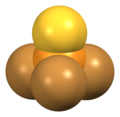| |||
| Names | |||
|---|---|---|---|
| Other names
Thiophosphoryl tribromide Phosphorus thiobromide Phosphorothioic tribromide | |||
| Identifiers | |||
| CAS Number | |||
| 3D model (JSmol) | |||
| ChemSpider | |||
| ECHA InfoCard | 100.021.367 | ||
| EC Number |
| ||
| PubChem CID | |||
| CompTox Dashboard (EPA) | |||
InChI
| |||
SMILES
| |||
| Properties | |||
| Chemical formula | PSBr3 | ||
| Molar mass | 302.75 g·mol | ||
| Appearance | yellow crystals | ||
| Density | 2.85 g cm | ||
| Melting point | 37.8 °C (100.0 °F; 310.9 K) | ||
| Boiling point | 212 °C (414 °F; 485 K) decomposes | ||
| Structure | |||
| Crystal structure | Cubic | ||
| Space group | Pa3, No. 205 | ||
| Lattice constant | a = 11.03 Å, b = 11.03 Å, c = 11.03 Å | ||
| Molecular shape | Tetrahedral at the P atom | ||
| Related compounds | |||
| Related compounds | |||
| Except where otherwise noted, data are given for materials in their standard state (at 25 °C , 100 kPa). Infobox references | |||
Thiophosphoryl bromide is an inorganic compound with the formula PSBr3.
Preparation
Thiophosphoryl bromide can be prepared by heating phosphorus tribromide with phosphorus pentasulfide, or with elemental sulfur in an inert atmosphere at 130 °C.
Thiophosphoryl bromide is one product of the bromination of P4S7 in cold carbon disulfide:
Structure and properties
Thiophosphoryl bromide has tetrahedral molecular geometry and C3v molecular symmetry. According to gas electron diffraction, the phosphorus–sulfur bond length is 1.895 Å and the phosphorus–bromine bond length is 2.193 Å, while the S=P−Br bond angle is 116.2° and the Br−P−Br bond angle is 101.9°.
Thiophosphoryl bromide is soluble in carbon disulfide, chloroform and diethyl ether.
Reactions
Like other phosphoryl and thiophosphoryl halides, thiophosphoryl bromide readily hydrolyses, undergoes nucleophilic substitution and forms adducts with Lewis acids. Reaction with lithium iodide generates the mixed thiophosphoryl halides PSBr2I and PSBrI2 but not thiophosphoryl iodide, PSI3. Thiophosphoryl bromide is of use in organic synthesis for reducing sulfoxides to thioethers, and sulfines to thioketones.
References
- ^ Greenwood, Norman N.; Earnshaw, Alan (1997). Chemistry of the Elements (2nd ed.). Butterworth-Heinemann. pp. 501–503. ISBN 978-0-08-037941-8.
- ^ William M. Haynes, ed. (2016). CRC Handbook of Chemistry and Physics (97th ed.). CRC Press. p. 4-78. ISBN 978-1498754293.
- "ICSD Entry: 39130". Cambridge Structural Database: Access Structures. Cambridge Crystallographic Data Centre. Retrieved 2022-10-30.
- ^ Arthur D. F. Toy (1975). The Chemistry of Phosphorus. Permanon Texts in Inorganic Chemistry. Vol. 3. Permanon Press. p. 438. ISBN 9781483139593.
- Jacob, E. Jean; Danielson, Donald D.; Samdal, Svein (1980). "An electron diffraction determination of the molecular structures of phosphoryl bromide and thiophosphoryl bromide". J. Mol. Struct. 62 (2): 143–155. Bibcode:1980JMoSt..62..143J. doi:10.1016/0022-2860(80)85232-X.
- van der Veer, W.; Jellinek, F. (1970). "Adducts of thiophosphoryl compounds with metal halides. Part III: Addition compounds of phosphoryl bromide and thiophosphoryl bromide". Recl. Trav. Chim. Pays-Bas. 89 (8): 833–844. doi:10.1002/recl.19700890809.
- Dillon, K. B.; Craveirinha Dillon, M. G.; Waddington, T. C. (1977). "The identification of some new thiophosphoryl compounds containing P–I bonds by means of P N.M.R. spectroscopy". Inorg. Nucl. Chem. Lett. 13 (8): 349–353. doi:10.1016/0020-1650(77)80109-8.
- Still, I. W. J.; Reed, J. N.; Turnbull, K. (1979). "Thiophosphoryl bromide: a new reagent for the reduction of sulfoxides to sulfides". Tetrahedron Lett. 20 (17): 1481–1484. doi:10.1016/S0040-4039(01)86183-9.
- Kuipers, J. A. M.; Lammerink, B. H. M.; Still, I . W. J.; Zwanenburg, B. (1981). "Phosphorus Pentasulfide and Thiophosphoryl Bromide: Facile Reagents for the Reduction of Sulfines to Thiones". Synthesis. 1981 (4): 295–297. doi:10.1055/s-1981-29423. S2CID 98302665.

